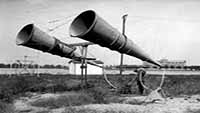 Loudness war is the name of some trends prevailing in music industry which lead to a gradual increase in loudness of mixes. Behind it lies a striving to emphasize your audio and make it be more noticeable on the background of the others. Loudness war is widely spread occurrence in a number of spheres of music mixing industry, yet more often it happens in the field of radiobroadcasting and album recording mainly of a commercial trend. In the latter case the trends of the increase in loudness have been caused by musicians’ and producers’ desire to release music product with loudness exceeding competitors.
Loudness war is the name of some trends prevailing in music industry which lead to a gradual increase in loudness of mixes. Behind it lies a striving to emphasize your audio and make it be more noticeable on the background of the others. Loudness war is widely spread occurrence in a number of spheres of music mixing industry, yet more often it happens in the field of radiobroadcasting and album recording mainly of a commercial trend. In the latter case the trends of the increase in loudness have been caused by musicians’ and producers’ desire to release music product with loudness exceeding competitors.
On the other hand, there’s a level limit. After you have achieved it, you can increase common loudness only with the help of extra dynamic processing at the loud mastering stage. Yet the unreasonable use of this stage always brings about sound distortion and signal amplitude compression. If you delve into the background of the case, you can find out some interesting facts. They noticed that in most cases much louder audios in jukeboxes are in better demand in comparison with much quieter tracks. After that interesting fact had been found out, record companies decided to add some loudness to audios to increase their competiveness.
However, there were vinyl records then, and because of their physical peculiarities they didn’t allow record companies to get bitterly carried away by the realization of those plans. It is commonly known that a vinyl record is a lacquer surface with fine grooves inscribed in it. Vibration recording of an analogue sound is made on these grooves.
 An important stage of any record producing is mastering mix when all audios are being leveled according to their loudness level. They are placed in the order which fulfills requirements of any carrier. In the case with vinyl in the process of album mastering it was necessary to search for the balance between loudness level and playback time especially thoroughly. That is to say, the increase in loudness caused decrease in amount of grooves capable of fixing much wider recording amplitude.
An important stage of any record producing is mastering mix when all audios are being leveled according to their loudness level. They are placed in the order which fulfills requirements of any carrier. In the case with vinyl in the process of album mastering it was necessary to search for the balance between loudness level and playback time especially thoroughly. That is to say, the increase in loudness caused decrease in amount of grooves capable of fixing much wider recording amplitude.
This issue was particularly topical for long playing records one side of which often contained not more than 20 minutes of sound. As an album included one or at most two vinyl discs (it was accounted for the pursuit of economy on manufacturing cost), in most cases in the war between time and loudness eventually time used to win. At that time only analogue mastering compressors were used and only separately applied to each channel of multitrack recording. However, some vocal mixing services started to use compressors to boost loudness level artificially on master bus up to the degrees which much more exceeded average data.
Mastering engineers “choked” dynamic range of an audio so that it was possible to amplify the level to the max and then to stay within the limits of possibilities of a vinyl medium. This mastering was usually used for singles which had only one song on each side of a record. In that case it was possible to inscribe grooves less closely as compared to standard long playing records. And now let’s come back to our time and reply to the question why listeners nevertheless prefer much louder recordings.
